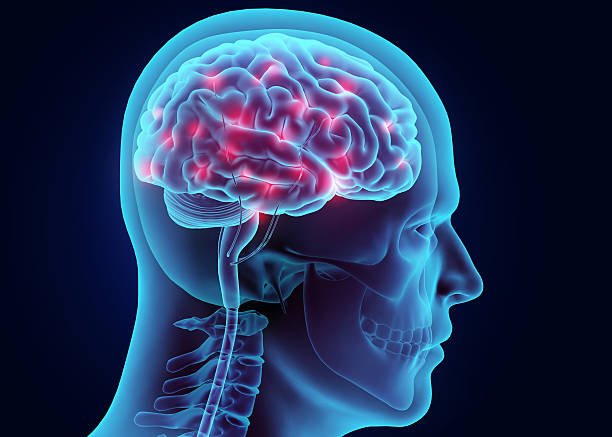Understanding about nervous system:
The nervous system is a sophisticated network of cells and nerves that transmits and receives messages between the brain, spinal cord, and different body organs. It detects and react to modifications both internal and external to the body. Nervous consist of the brain, spinal cord and the peripheral nerves.
The nervous system consist of the huge amount of cells, known as neurons, are held up by neuroglia, a unique kind of connective tissue.

The nervous system are grouped as follows:
Central nervous system (CNS):
The brain and spinal cord make up the central nervous system.
Peripheral nervous system (PNS):
Peripheral nervous system comprises paired cranial and sacral nerves. There are three types of sensory perception: sensory (afferent), motor (efferent), and mixed.
Genetic neurological disorders:
Genetic neurological disorders are conditions caused by changes or mutations in the genetic code that affect the nervous system’s structure and function. There is an extensive range of symptoms and problems associated with these illnesses.
Here’s an overview of some common genetic neurological disorders, their symptoms, and causes:
1. Huntington’s Disease:
Huntington’s disease (HD) is a progressive, genetic neurodegenerative disorder that affects the brain, leading to motor dysfunction, cognitive decline, and psychiatric symptoms. It is caused by a genetic mutation and typically manifests in adulthood.
Symptoms:
Involuntary jerking or writhing movements (chorea)
Muscle issues, like tightness or stiffness (dystonia).
Slow or abnormal eye movements
Impaired gait, posture, and balance
Difficulty with speech or swallowing
Cognitive issues, such as difficulty planning, organizing, and focusing
Psychological disorders include anxiety, sadness, and obsessive-compulsive disorder.
Causes:
Huntington’s disease is caused by a mutation in the HTT gene, which provides instructions for making the huntingtin protein. This mutation involves an abnormal repetition of the CAG nucleotide sequence in the DNA, leading to the production of an abnormal protein that gradually damages neurons.
2. Duchenne Muscular Dystrophy (DMD):
A genetic condition known as Duchenne Muscular Dystrophy (DMD) is characterized by increasing weakening and degradation of the muscles. It is one of the most severe types of muscular dystrophy and primarily affects boys, although girls can be carriers and may exhibit milder symptoms.
Symptoms:
Muscle weakness, starting in the hips, pelvic area, thighs, and shoulders
Difficulty walking, running, and jumping
Frequent falls
Enlarged calf muscles (pseudohypertrophy)
Learning disabilities and cognitive impairment
Progressive difficulty breathing and heart problems as the disease advances
Causes:
DMD is caused by mutations in the DMD gene, which encodes dystrophin, a protein that helps maintain muscle cell structure. The lack of functional dystrophin leads to muscle degeneration and weakness.
3. Fragile X Syndrome:
Fragile X Syndrome (FXS) is a genetic disorder caused by a mutation in the FMR1 gene on the X chromosome. This condition leads to a range of developmental problems, including intellectual disabilities, behavioral and learning challenges, and distinct physical characteristics. The most frequent hereditary cause of autism and intellectual disability is FXS.
Symptoms:
Intellectual disabilities ranging from mild to severe
Delayed development of speech and language
Hyperactivity and impulsive behavior
Anxiety and mood swings
Autistic behaviors, such as hand-flapping, repetitive actions, and social avoidance
Physical features like a long face, large ears, and flat feet
Causes:
Fragile X syndrome is caused by an expansion of the CGG triplet repeat within the FMR1 gene on the X chromosome. This expansion leads to the silencing of the gene and a lack of the fragile X mental retardation protein (FMRP), which is crucial for normal neural development.
4. Amyotrophic Lateral Sclerosis (ALS):
Lou Gehrig’s disease, or amyotrophic lateral sclerosis (ALS), is a progressive neurological illness affecting motor neurons in the brain and spinal cord. These motor neurons control voluntary muscle movements, and their degeneration leads to muscle weakness, paralysis, and ultimately, respiratory failure.
Symptoms:
Muscle weakness and atrophy, starting in the arms and legs
Difficulty speaking, swallowing, and breathing
Muscle cramps and twitching (fasciculations)
Stiff or rigid muscles (spasticity)
Gradual loss of voluntary motor control, leading to paralysis
Causes:
While most ALS cases are sporadic, about 5-10% are familial and caused by mutations in genes such as SOD1, C9orf72, TARDBP, and FUS. These mutations lead to the degeneration of motor neurons, which control voluntary muscles.
5. Rett Syndrome:
Rett Syndrome is a rare inherited neurological condition that mainly affects females and causes significant physical and cognitive disabilities. It is characterized by normal early growth followed by a period of regression, during which motor skills and speech are lost, and distinctive repetitive hand movements develop.
Symptoms:
Normal early growth followed by loss of purposeful hand skills and development of repetitive hand movements (e.g., wringing or clapping)
Slowed growth, particularly of the head (microcephaly)
Loss of speech and motor control
Problems with walking and coordination
Breathing irregularities, such as hyperventilation or breath-holding
Seizures and cognitive disabilities
Causes:
Rett syndrome is primarily caused by mutations in the MECP2 gene, which is important for brain development and function. These mutations predominantly affect females, as males with the condition usually do not survive infancy.
6. Spinal Muscular Atrophy (SMA):
Spinal Muscular Atrophy (SMA) is a genetic disorder characterized by the progressive degeneration of motor neurons in the spinal cord and brainstem. This leads to muscle weakness and atrophy. SMA primarily affects voluntary muscles used for activities such as crawling, walking, head and neck control, and swallowing.
Symptoms:
Muscle weakness and atrophy, most severe in the muscles closest to the center of the body (proximal muscles)
Difficulty with sitting, standing, and walking
Respiratory issues and difficulty swallowing in severe cases
Normal cognitive development
Causes:
The survival motor neuron (SMN) protein is made by the SMN1 gene, and mutations in this gene cause SMA. This protein is essential for the maintenance of motor neurons, and its deficiency leads to their degeneration.
Genetic Testing and Diagnosis:
Diagnosing genetic neurological disorders typically involves:
Clinical Evaluation: Assessment of symptoms and family history.
Genetic Testing: Identifying mutations through blood tests, DNA analysis, and other molecular diagnostic tools.
Imaging Studies: MRI and CT scans to observe structural changes in the nervous system.
Electrophysiological Tests: EMG and nerve conduction studies to evaluate electrical activity in muscles and nerves.
Management and Treatment:
While many genetic neurological disorders currently have no cure, treatments focus on managing symptoms and improving quality of life:
Medications: To control symptoms such as seizures, muscle spasms, and psychiatric issues.
Physical and Occupational Therapy: The goal of physical and occupational therapy is to preserve function and mobility.
Speech Therapy: To assist with communication difficulties.
Surgical Interventions: In some cases, to address specific symptoms or complications.
Supportive Care: Including respiratory support and nutritional assistance.
